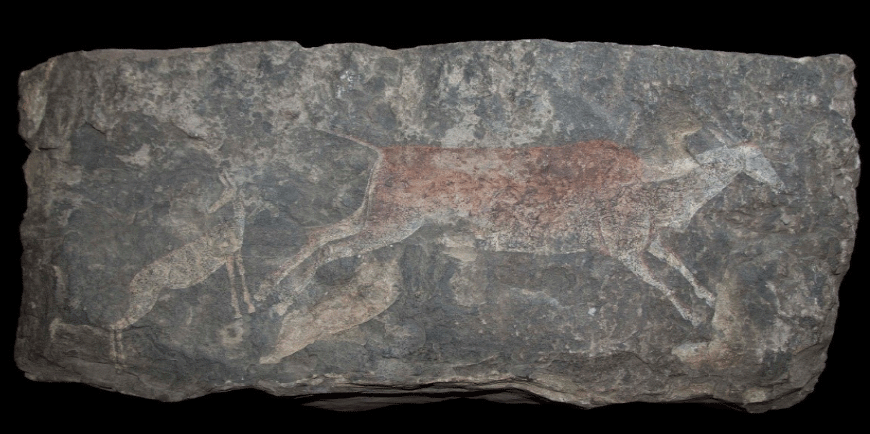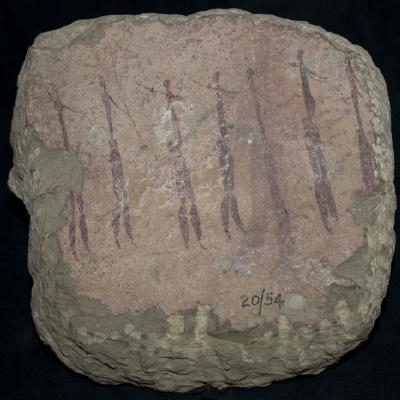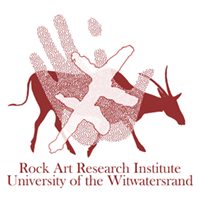
Rock Art Research Institute (RARI) has a total of 266 original rock art pieces that it curates on behalf of the nation. These rocks comprise both paintings and engravings and they are held in separate collections according to the donor/collector of the pieces. Many pieces from these collections are on display in the Wits Origins Centre museum.

 In December 1943, a survey team from the South African Archaeological Survey, led by Professor Clarence van Riet Lowe and the Abbe Henri Breuil, conducted field work around the town of Ladybrand in the Eastern Free State of South Africa. Although their initial intent was the investigation of Rose Cottage Cave, they found many sites in the area that contained rock paintings and stone tools. The survey team was assisted by an enthusiastic member of the Ladybrand establishment, Paul Lowenstein, who showed them many sites and who presented them with a collection of stone tools and two dozen rock paintings and engravings that he had collected from throughout South Africa. These rock paintings and engravings are now housed as the Lowenstein Collection in the Rock Art Research Institute of the University of the Witwatersrand. In addition to the original rock art pieces is a folio of Henri Breuil colour copies of the rock paintings of Rose Cottage Cave. The folio was presented to Lowenstein by Henri Breuil in thanks for his support of the Archaeological Survey. This folio was purchased from the Lowenstein family by the Rock Art Research Institute in 2004.
In December 1943, a survey team from the South African Archaeological Survey, led by Professor Clarence van Riet Lowe and the Abbe Henri Breuil, conducted field work around the town of Ladybrand in the Eastern Free State of South Africa. Although their initial intent was the investigation of Rose Cottage Cave, they found many sites in the area that contained rock paintings and stone tools. The survey team was assisted by an enthusiastic member of the Ladybrand establishment, Paul Lowenstein, who showed them many sites and who presented them with a collection of stone tools and two dozen rock paintings and engravings that he had collected from throughout South Africa. These rock paintings and engravings are now housed as the Lowenstein Collection in the Rock Art Research Institute of the University of the Witwatersrand. In addition to the original rock art pieces is a folio of Henri Breuil colour copies of the rock paintings of Rose Cottage Cave. The folio was presented to Lowenstein by Henri Breuil in thanks for his support of the Archaeological Survey. This folio was purchased from the Lowenstein family by the Rock Art Research Institute in 2004.
The Rock Engraving Archive comprises rock art that was displayed at Johannesburg Zoo from the 1970s until the 1990s as well as a collection of rocks with images from MuseumAfrica. Those that were displayed in the zoo originally came from the Northwest Province. The exhibit was placed under the curation of the Africana Museum (now MuseumAfrica) for administrative purposes. The exhibit was difficult to maintain and the museum staff grew increasingly uncomfortable about the social implications of displaying indigenous art in the context of a zoological garden. In the early 1990s, together with the Rock Art Research Institute, it was agreed that the zoological gardens rock engraving exhibit should be closed. All of the smaller pieces were removed from the Zoo and taken to MuseumAfrica. Many were then placed in a new rock display that was designed and built in collaboration with staff from the Rock Art Research Institute. 36 large rocks remained at the Zoo because the floors of MuseumAfrica could not support their weight. These rock engravings suffered badly and became entirely covered in moss and lichen. In May 2000, thanks to funding from the Department of Arts, Culture, Science and Technology, the Rock Art Research Institute agreed to house these large rock engravings in a dedicated indoor storage facility on the West Campus of Wits University. Between 2000 and 2004 a team of conservators worked on the cleaning and conservation of these engravings, delicately drying out stones and removing all traces of lichens and moss. The collection is now restored, as best it can be, to its original condition and the pieces are back on display in the newly opened wing of the Origins Centre rock art museum. The fabric of many of the rocks has been so damaged by the moisture and pollution of central Johannesburg that they can never be displayed again in an outdoor setting.
Between the 1920s and 1960s it was believed that the best way to protect the rock paintings and engravings from destruction by natural erosion, corrosion, vandalism, fires and cattle rubbing was to remove them from their locations and to take them to museums for safe preservation. It was primarily for this reason that the Africana Museum (now MuseumAfrica) Consultative Committee and the Historical Monuments Commission agreed to allow the removal of rock art pieces from their original locations by amateur enthusiasts, archaeologists and artists such as the famed Walter Batiss. Rock art was collected from the Magaliesberg, Eastern Cape and Rustenburg. It was thought that the images would be widely enjoyed by visitors to the museum and that the museum could protect the art for all time from deterioration. For some sites this has certainly been the case. The rock art left at Wartrail, a farm near Barkly East, for example, has been almost entirely destroyed by natural processes since the 1940s. Had the Wartrail panel not been removed, there is a good chance it would not have survived to be appreciated today.
Having said this, researchers never remove rock art from its original setting today unless it is threatened with destruction from a dam or road building project or other similar development. It is now understood that in many cases, removing the paintings actually causes further damage. Additionally, the removal of an image makes it difficult, if not impossible, to interpret because the original context is lost. Rock art is protected under South African law and it is a criminal act to remove or try to remove any without permission from the South African Heritage Resources Agency (SAHRA).

On the 22nd March 2005 all the MuseumAfrica rock art pieces were transferred to the Rock Art Research Institute to ensure their long-term conservation and display. The Wartrail and other famous panels are now on display in the Origins Centre Museum.


